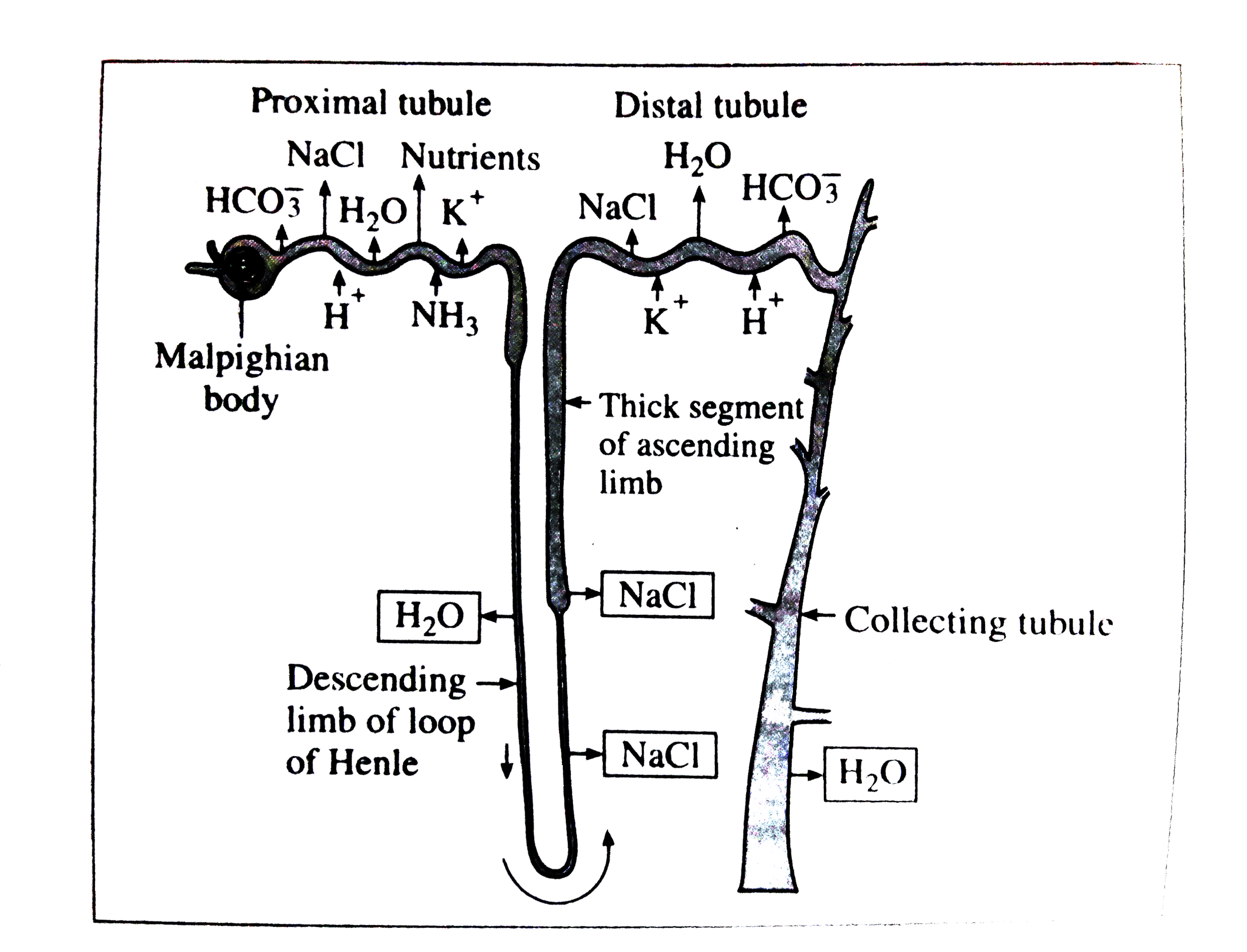Describe the physiology or mechnism of urine formation.
Text Solution
Physiology of urine formation /Mechnism of urine formation : Urine formation takes place in three stages. These are ultrafiltration , selective reabsorption and tubular secretion.
(I) Ultrafiltration :
(1) This is a pysical process taking place in the Malpighian body. The diameter of afferent renal arteriole is larger than the diameter of efferent renal arteriole and hence there is hydrostatic pressure developed on the contents inside the blood vessels in the glomerulus. This pressure is alled effective filtration pressure or EFP.
(2) 99% of the filtrate is reabsorbed and only 1 to 1.5 litre of urine is formed per day .
(3) Outer parietal layer and inner visceral layer of Bowman's capsule enclose a space called urinary space. The innr visceral layer contains podocytes which are specialized cells.
(4) Due to semiprmeable glomerular endothelial membrane, low molecular weight substances are pulled out of the blood and enter into urinary space. This filtrate is blood plasma except proteins and blood corpuscles.
(II) Selective reabsorption.
(1) In this process 99% of the filtrate is reabsorbed.
(2) There are two processes involved in this step : Passive transport for osmosis and active transport. Active transport uses ATP molecules since it is against the concentratioin gradient.
(3) When the filtrate passes through the renal tubule there is exchange of substances between the surrounding blood and renal tubular fluid.
(4) High threshold substances e.g., glucose, amino acids, potassium and calcium ions, etc. are completely reabsorbed. Urea and uric acid are low threshold substances. They are reabsorbed negligibly.
(5) Water us reabsorbed everywhere except in the ascending loop of Henle. This absorption occurs by osmosis and is known as obligatory absorption of water.
(6) Amino acids and ions are pumped out from PCT. Glucose is maximally reabsorbed in healthy persons so that no glucose molecules remain in the urine.
(III) Tubular secretion :
(1) Some abnormal and unwanted substances which have passed into peritubular capillaries are secreted back in DCT, during this process.
(2) Nitrogenous substances like creatinine and ions like potassium and hydrogen are also taken back in the lumen of uriniferous tubule through for peritubular capillaries.
(3) Secretion of hydrogen ions is in important homeostatic mechanism to keep the balance of the acidity of the blood.
(4) Sodium ion concentration is maintained by aldosterone while calcium ion concentration is maintaind by calcitonin and parathor-mone.
(5) If any toxic and abnormal constituent is present in the body it is secreted back into urine, in this stage.

|
Topper's Solved these Questions
- LONG ANSWER QUESTIONSBOOK - NAVNEET PUBLICATION - MAHARASHTRA BOARDCHAPTER - LONG ANSWER QUESTIONSEXERCISE - Control and Coodination
13 Videos
- LONG ANSWER QUESTIONSBOOK - NAVNEET PUBLICATION - MAHARASHTRA BOARDCHAPTER - LONG ANSWER QUESTIONSEXERCISE - Human Reproduction
8 Videos
- LONG ANSWER QUESTIONSBOOK - NAVNEET PUBLICATION - MAHARASHTRA BOARDCHAPTER - LONG ANSWER QUESTIONSEXERCISE - Circulation
10 Videos
- GIVE REASONS BOOK - NAVNEET PUBLICATION - MAHARASHTRA BOARDCHAPTER - GIVE REASONS EXERCISE - Organisms and Environment - II
2 Videos
- MATCH THE COLUMNS/MATCH THE PAIRS/COMPLETE THE TABLEBOOK - NAVNEET PUBLICATION - MAHARASHTRA BOARDCHAPTER - MATCH THE COLUMNS/MATCH THE PAIRS/COMPLETE THE TABLEEXERCISE - Chapter 19 : Organisms and Environment - II
3 Videos
Similar Questions
Knowledge Check
First step in urine formation is
ATubular secretionBTubular reabsorptionCUltrafiltrationDSelective secretion
(a) Describe the mechainsm of urine formation in human excretory sytem. Draw a labelled diagram to illustrate your answer.
(b) where is urine carried through ureters ?
(c) What is urethra ?
View SolutionFirst step in urine formation is
View SolutionName the firs tstep of urine formation.
View SolutionName the first step of urine formation.
View SolutionHow is structure of kidney related to the function of excretion? Describe the process of urine formation in humans.
View SolutionUrine Formation Part-1
View SolutionUrine Formation Part-2
View Solution
